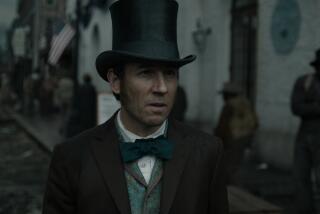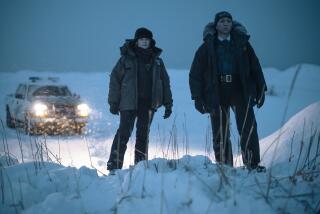David Suchet bids farewell to Agatha Christie’s Poirot
GALMPTON, England — The final push to the top of his personal Everest consisted of about 50 dainty steps, in the precise and idiosyncratic gait he has perfected over 25 years.
David Suchet paced up to the door of the house, glanced around, gave a tip of his hat and the ghost of a smile, and disappeared inside. When the cameras stopped rolling, he emerged and raised his arms in triumph as a crew member called a wrap on one of the most remarkable achievements in recent British television history.
It was the last day of filming — ever — for Suchet as Agatha Christie’s famous detective Hercule Poirot, a character he first played in 1988 and that has become the defining role of his career.
PHOTOS: Hollywood backlot moments
No one could’ve guessed then that the series would span a quarter-century or that the classically trained Suchet would complete the entire catalog of whodunits featuring the eccentric Belgian investigator, including 33 novels and dozens of short stories. Or that, with a sense of poetic justice, the final shot would take place at Christie’s own summer home here in southwest England, a Georgian manor set in the gorgeous green countryside of her native Devon.
“Extraordinary, absolutely extraordinary,” said Suchet, who waved away any suggestion of grief over the end of his life with Poirot. “I don’t think you can ask anybody who’s reached the summit of Everest whether they’re sad.”
The climb has entailed 70 episodes, with dead bodies littered all over the world — mostly in England, but also on the Orient Express, a Nile steamer and a plane bound from Paris to London. Filming of the final five full-length features finished at the end of June; one of them, “Elephants Can Remember,” has already aired on Britain’s ITV, with the rest to follow in the fall.
American viewers will be able to watch the new episodes next year on PBS, where the show draws an audience of about 5 million, and a national rating about 80% higher than the public network’s prime-time average. “Agatha Christie: Poirot” is also popular in Brazil, Finland and Japan, among other countries, making Suchet, 67, an international star. (There have been other memorable Poirots, notably Albert Finney in “Murder on the Orient Express” and Peter Ustinov in “Death on the Nile,” but most fans regard Suchet’s portrayal as the definitive Poirot.)
PHOTOS: Taking off Poirot’s hat for good
He’s grateful for that because it has afforded him the luxury of pursuing less lucrative jobs in between, particularly on the stage, where he has built up a sterling résumé. Critics showered praise on his 2010 turn in Arthur Miller’s “All My Sons” in London’s West End, in which Suchet performed with Zoe Wanamaker, who also plays his sidekick in several of the recent “Poirot” programs.
“‘Poirot’ … has literally subsidized the other side of my career, which is my theater side,” he said. “One has paid for the other, so I come out not broke, which is very lucky.”
It was only about eight years ago, after he had starred in about 50 episodes, that Suchet realized he was approaching striking distance of completing the canon of Poirot stories. He soon made it his personal ambition.
By then, he’d already spent more than a third of his adult life getting used to the extravagant fake mustache and extra padding — he calls it his “armadillo” suit — along with the fussy mannerisms, outsized vanity, Belgian accent and penguin-like walk of Poirot. The series had become enough of an institution to attract big names from both sides of the Atlantic, including Elliott Gould, Jessica Chastain, Barbara Hershey, Hugh Bonneville, Michael Fassbender and Greta Scacchi.
But even as the list of outstanding works shrank and the finishing line loomed, there was never a guarantee that “Poirot” would be renewed whenever it went on hiatus, which sometimes lasted two years or more. In 2011, speculation swirled that the series was done for, until ITV announced that it would commission the remaining five episodes after all, to the relief of both Suchet and his fans.
“I was always anxious that it would never happen, right until the end,” the actor said, his real voice a much richer baritone than his character’s. “I have not known any year whether I was going to do it the next year. It was literally touch and go.”
PHOTOS: Celebrities by The Times
In addition to “Elephants Can Remember,” the new episodes are “The Big Four,” “The Labors of Hercules,” “Dead Man’s Folly” and “Curtain: Poirot’s Last Case,” in which the detective dies after an illustrious career stretching from the mid-1920s till just before Christie’s own death in 1976. She wrote “Curtain” in the ‘40s, but it was locked away in a vault before being published in 1975, a literary event that prompted the New York Times to run its first front-page obituary of a fictional character.
Early on in the TV series, the makers decided to set every episode in the 1930s no matter when it was written. That allowed them to pour on the fabulous Art Deco details — “we have people who watch ‘Poirot’ for the cars,” said Rebecca Eaton, executive producer of PBS’ “Masterpiece” — and that lends the series a comforting nostalgia, a sort of “Downton” of death.
It also enabled producers to shoot the stories out of their written sequence, as happened with the final five adaptations. “Curtain,” which will be the last to air, was filmed first, because it was easier for Suchet to lose weight to play an aged, frail Poirot and then gain it back for the remaining episodes.
There were emotional reasons too.
“I would’ve hated to leave the character dead,” Suchet said. “Now I can leave him alive and kicking and feeling well.”
The last episode to be made was “Dead Man’s Folly,” which includes settings — a boathouse, the garden of an English country house — that Christie based on her own summer home, Greenway, here in Galmpton, overlooking the River Dart. (The property now belongs to the National Trust and is open to the public.) Using it in the TV version was a no-brainer.
“Originally we only had the funding to do just the boathouse and establish just the river, and then we came and scouted down here and we said it’s crazy not to have the face of the house,” said producer David Boulter. “So we scratched our heads and came up with a way of affording a few more days down here.”
IN CASE YOU MISSED IT: Emmys 2013 - Full coverage
With the sense of closing a circle, producers contrived it so that the final shot would be of Suchet walking up to the porch in full Poirot regalia of sharply pressed suit and shiny patent-leather shoes, though the scene features early in the film.
The day, June 27, started out beautifully sunny but clouded over and began spitting rain. The production went ahead, and, watched by an admiring crowd that included Christie’s grandson, Suchet minced his way into TV history.
What lies on the other side for him is partly known, partly not. Besides completing the Poirot oeuvre, he is wrapping up recording a spoken version of the entire Bible and has a documentary on St. Peter in the works, to complement one he made on St. Paul.
He has expressed an interest in doing some comedy. Ironically, said Boulter, after 25 years of bringing killers to justice, Suchet would make a great villain.
“He does a really good baddie,” Boulter said. “There aren’t that many actors of that caliber around, British actors, and I think he’ll get some fantastic roles now in independent film.”
More to Read
The complete guide to home viewing
Get Screen Gab for everything about the TV shows and streaming movies everyone’s talking about.
You may occasionally receive promotional content from the Los Angeles Times.







